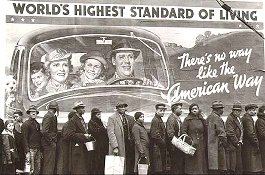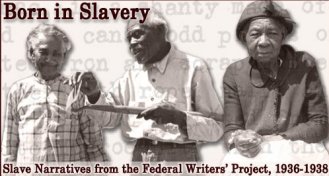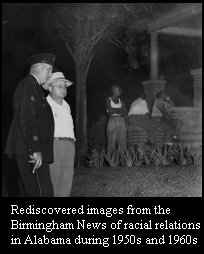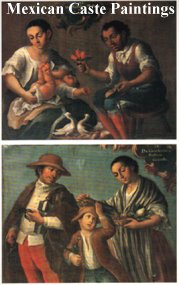RACE & ETHNICITY
In 1986, Japanese Prime Minister Yasuhiro Nakasone remarked that the
average American intellectual standard is lower than the average Japanese
standard because of the blacks and Hispanics in the U.S. He has often said
that the source of Japan's strength lies in its "racial homogeneity." Eleven
years later, University of Texas Law School Professor Lino Graglia triggered
a firestorm of criticism for his remarks that "Blacks and Mexican-Americans
are not academically competitive with whites in selective institutions.
It is the result primarily of cultural effects. They have a culture that
seems not to encourage achievement. Failure is not looked upon with disgrace."

It has been said that race is the plague of civilization. In 1977, Andrew Young, at that time the chief U.S. representative
to the United Nations, claimed that a race war in South Africa would inevitably
precipitate racial conflict in the United States. Some countries, like
Great Britain and Australia, eliminate the potential for conflict by simply
denying or severely limiting entry.
However, American society has always been enriched by its waves of
immigrants. John Kennedy observed how Alexis de Tocqueville saw the United
States as "a society of immigrants, each of whom had begun life anew, on
an equal footing. This was the secret of America: a nation of people with
the fresh memory of old traditions who dared to explore new frontiers ..." In
2004, the Census Bureau predicted that in the year 2050 minority groups would
comprise one-half of the total American population of 420 million.
Hispanics will comprise roughly one-quarter of the population, blacks 15%, and
Asians 8%.
As the proportion of Americans increasingly becomes Hispanic,
black and Asian, inequalities grow. According to the Pew Hispanic Center's
2004 "The
Wealth of Hispanic Households: 1996 to 2002" study, "the
median net worth of Hispanic households in 2002 was $7,932. This was only nine
percent of $88,651, the median wealth of non-Hispanic White households at the
same time. The net worth of Non-Hispanic Blacks was only $5,988. Thus, the
wealth of Latino and Black households is less than one-tenth the wealth of White
households even though Census data show their income is two-thirds again as
high."
Here we consider some of the sociological facets of race and ethnicity,
and how they are interwoven with other dimensions of social
stratification.
ETHNICITY AND
RACE:
GENERAL INDEXES
MINORITY GROUP = A group typically numerically inferior to the rest
of the population of a state, in a non-dominant position, whose members--being
nationals of the state-- possess ethnic, religious, or linguistic characteristics
distinguishing them from the rest of the population. Typically, members
of a minority group share a sense of solidarity and a desire to preserve
their culture, traditions, religion, or language. A minority group can
sometimes be a numerical majority in a minority group position. Minority
group status is not a matter of numbers; it is determined by the presence
of distinguishing features such as discrimination. Central features characterizing
a minority group are:
-
The members of a minority group suffer various disadvantages at the
hand of another group;
-
A minority group is identified by group characteristics that are socially
visible;
-
A minority is a self-conscious group with a strong sense of "oneness";
-
People usually do not become members of a minority group voluntarily;
they are born into it;
-
By choice or necessity, members of a minority group tend to marry within
the group."
[Source, A.J. Jongman & A.P. Schmid. Monitoring Human
Rights. Manual for Assessing Country Performance. Leiden, LISWO, 1994.
350 pp. + software, p.257 (from Part III:Glossary, which defines some 750
terms).]
-
"All of Us Are Related, Each of Us is Unique" an
exhibit on the illusion of race from Syracuse University

-
Ethnicity-Migration-Racism links
from SocioSite
-
Voice of the
Shuttle: Minority Studies Page
-
American
Studies Web: Race, Ethnicity & Identity
-
European Centre for Minority Issues [.pdf]
-
National Network for Immigrant and Refugee
Rights
-
From the University of Washington,
EServer.org: Materials on race and ethnicity in the U.S.
-
Allyn and
Bacon's "Race, Ethnicity, and Inequality" links
-
Diversity
-
The World-Wide
Web Virtual Library: Migration and Ethnic Relations
-
International Migrations & Ethnic
Relations
-
Interracial
Voice

AFRICAN AMERICANS
The only group to have involuntarily immigrated to the United States,
to have been forcibly stripped of its culture, African or black Americans
has as a group yet to receive its fair share of the American dream. Of
those surveyed in a Fall 1995 TIME/CNN poll, 56% of blacks did not believe
that discrimination against them would ever diminish (compared to 27% of
whites). And while near two-thirds of whites thought that race relations
would eventually improve, only 44% of blacks agreed.
 But it is worth remembering how
much change has occurred in recent decades. Read, for instance, about the
1955 murder of 14-year-old
Emmett Till or the
lynching
postcards of last century (see also
Without Sanctuary: Lynching Photography in America; for state lynching rates 1882-1927 click
here). As recently as the 1960s,
Southern blacks could not even drive on the same road as whites, having
to pull over to the side and wait until the road was again theirs. (See the
National Park Service's "We
Shall Overcome: Historic Places of the Civil Rights Movement.") In March
of 1995 Mississippi lawmakers finally ratified the 13th Amendment, the
one abolishing slavery--130 years after the fact. Click
here to see the 1997 Gallup Poll Social Audit on Black/White Relations.
Other fact-filled resources include the
National Urban League's annual report on the progress of African Americans, "The
State of Black America 2000: Blacks in the New Millennium" and The
Journal of Blacks in Higher Education.
But it is worth remembering how
much change has occurred in recent decades. Read, for instance, about the
1955 murder of 14-year-old
Emmett Till or the
lynching
postcards of last century (see also
Without Sanctuary: Lynching Photography in America; for state lynching rates 1882-1927 click
here). As recently as the 1960s,
Southern blacks could not even drive on the same road as whites, having
to pull over to the side and wait until the road was again theirs. (See the
National Park Service's "We
Shall Overcome: Historic Places of the Civil Rights Movement.") In March
of 1995 Mississippi lawmakers finally ratified the 13th Amendment, the
one abolishing slavery--130 years after the fact. Click
here to see the 1997 Gallup Poll Social Audit on Black/White Relations.
Other fact-filled resources include the
National Urban League's annual report on the progress of African Americans, "The
State of Black America 2000: Blacks in the New Millennium" and The
Journal of Blacks in Higher Education.
 The thirtieth anniversary of Dr. Martin Luther King's death in 1998
produced considerable stocktaking. Take a look at PBS Frontline's page
"The
Two Nations of Black America", which features economic trends data and
interviews with Eldridge Cleaver, Julian Bond, Jesse Jackson, Angela Davis, and
William Julius Wilson. Also worth a look is
Voices of Civil Rights, an
online archive of materials from the civil rights movement.
The thirtieth anniversary of Dr. Martin Luther King's death in 1998
produced considerable stocktaking. Take a look at PBS Frontline's page
"The
Two Nations of Black America", which features economic trends data and
interviews with Eldridge Cleaver, Julian Bond, Jesse Jackson, Angela Davis, and
William Julius Wilson. Also worth a look is
Voices of Civil Rights, an
online archive of materials from the civil rights movement.
HISTORICAL PERSPECTIVES OF
THE AFRICAN
AMERICAN EXPERIENCE


-
Frederick Douglass,
"What to the Slave is the Fourth of July?" (July 5, 1852)
-
Frederick Douglass,
"Reconstruction
" (Dec. 1866)
-
Booker T. Washington,
"The
Awakening of the Negro" (Sept., 1896)
-
W.E.B. Du Bois, "Strivings
of the Negro People" (Aug., 1897)
-
Booker T. Washington,
"The
Case of the Negro" (Nov., 1899)
-
W.E.B. Du Bois, "The
Training of Black Men" (Sept., 1902)
-
Ralph
McGills' reflections of his 1963 interview with Du Bois (Nov. 1965)
-
Martin Luther King, "Letter
from Birmingham Jail: The Negro is Your Brother" (Aug., 1963)
Other resources:
INSTITUTIONAL CASE
STUDIES
-
"History of Race in Science"
(project of Evelynn Hammonds, Michelle Murphy, and Stephanie Higgs of
MIT)
-
Brookings Institution
Research on Race and Minority Politics
-
Joint Center for Political and Economic Studies, founded in 1970, a non-profit institution
that conducts research
on political, economic, and social policy issues of concern to African Americans.

-
Congressional Black Caucus Foundation
-
For history of African Americans in film see Michael Mills' Midnight Ramble
CONTEMPORARY PERSPECTIVES
-
African American Newspapers listings sorted by state
-
The Black Commentator "Commentary, analysis and investigations into issues affecting African Americans"
DATA AND
GRAPHS
-
African-American
Population
Statistics
-
Cardiovascular disease
in the Black population
THE WORKINGS OF THE
"MELTING POT": INTERMARRIAGE
Certainly one mechanism by which the American melting pot works is through
the intermarriages of different racial, ethnic, and national groups.
By 1980, according to the U.S. Census, only one quarter of American-born,
non-Hispanic whites was married to someone with an undivided ethnic heritage
identical to his or her own. Take, for instance, the case of Italian Americans:
of those born before 1920, some 8 percent had mixed ancestry, compared
to over 70 percent of those born after 1970.
The melting pot has not, however, melded that many unions across
racial lines. Roughly 99 percent of African American women and 97 percent
of African American men marry one of their race. This is not to deny that
considerable changes have occurred in recent decades. For every 100,000
married couples in the United States, in 1990 there were 396 black-white
unions, compared to 126 in 1960.
Public attitudes and state laws have not historically promoted biracial
marriages. Until the 1967 Loving
v. Virginia Supreme Court decision, sixteen
states, most of them Southern, had anti-miscegenation laws preventing such
couplings. Since 1972, the NORC General Social Surveys have included the
question "Do you think there should be laws against marriages between Blacks
and whites?" In the 1972-75 period, some 38 percent of white Americans
agreed with the statement. By the 1990s, only 18 percent agreed. Looking
at levels of agreement by birth cohorts over time, observe that support
for miscegenation laws consistently declines the younger the cohort and
that cohort consensus remains basically constant over time.
THINKING ABOUT RACIAL
STEREOTYPES
The dust has yet to settle from Richard J. Herrnstein and Charles Murray's
The Bell Curve: Intelligence and Class Structure in American Life.
Therein it is claimed that the social and economic advantages whites have
over blacks is due to their greater intelligence. Among the many shortcomings
of the authors' logic and methodology is the simple fact that there is
only one species of the human race; it cannot be broken into biological
units such as race. Further, in studying the variability of intelligence
between those in our racial taxonomy, molecular biologists have found that
more than 85 percent is among individuals within the same race.
Nevertheless, most of us hold preconceived theories about attributes
of those in various groups and view others through their stereotypes. For
instance, three-quarters of African-Americans believed in 1994 that whites
are "insensitive to other people" and 42 percent said that Asian-Americans
are "unscrupulously crafty and devious in business" (Harper's Magazine,
1994). Stereotyping is undoubtedly a natural process, used by individuals
to simplify the world and to make life somewhat predictable. Nevertheless,
we always need to remember the maxim of W.I. Thomas that if people believe
something to be true it will be true in its consequences.
Let's examine Americans' perceptions of the intelligence of whites
and blacks. In 1990, the National Opinion Research Center asked a random
sample of non- institutionalized, English-speaking Americans 18 years of
age and older a series of questions dealing with characteristics of various
racial and ethnic groups. Included were the following: Do the people
in the following groups tend to be unintelligent (1) or do they tend to
be intelligent (7)? Whites? The intelligence of Blacks? Here analyzed
are the differences in intelligence scores given by white and black
Americans. If, for instance, a person gave an intelligence score of 4 for
whites and 4 for blacks, then that person sees no racial difference; if
one scores whites as 4 and blacks as 5 then that person sees blacks as
generally being more intelligent than whites. Presented in the graphs below
are the mean difference scores given by whites and blacks broken down by
age and by education.
Click here to see
How do you interpret these correlations? Consider framing
them in
terms of Derrick Bell's
("Dr. King's Legacy: A Help or Harm in the Racial
Struggle?" Trinity's Martin Luther King keynote speech presented on
Jan. 17, 2000) thesis that blacks are the key societal glue, the social
stabilizers, of American society as they are always perceived to be below
everyone else. Even the poorest whites still see themselves better than
blacks and thus do not agitate the system for social change. And the new
immigrants from Asia and Latin America have learned this mindset as
well. In sum, without racism the American melting pot does not
work.
To investigate how racism might take the fizz out of class conflict, consider
the following table from the GSS:
% WHITES
AGREEING THAT "LARGE DIFFERENCES IN INCOME
ARE NECESSARY FOR AMERICA'S PROSPERITY (n=706)
| EDUCATION: |
HS DROPOUT |
HS GRAD |
SOME POST-SECONDARY |
4+ YEARS COLLEGE |
TOTAL |
| Believe blacks smarter or as smart as
whites |
34% |
28% |
25% |
16% |
24% |
| Believe whites are smarter than blacks |
38% |
31% |
42% |
43% |
37% |
From the TOTAL column on the
right we observe that whites believing that they are smarter than blacks are
more likely to agree that national prosperity requires large differences in
income--an important belief for a status quo that features one of the largest
gaps between the haves and have-nots in the developed world.

HISPANIC AMERICANS
As recently as 1950, the Census counted fewer than 4 million U.S. residents
who would fall under the catch-all category "Hispanic" (see Linda Robinson's
Hispanics
don't exist" on the supposed 17 major Latino subcultures in the U.S.).
By 2001 there was an estimated 37 million Hispanic Americans, or nearly 13% of the
total population, and their numbers were growing nearly five times faster than the general
public (see Census Brief, "The
Hispanic Population"). According to a 2003 Census
Bureau report, Hispanics surpassed blacks as America's largest minority
group. For one perspective of the implications of this demographic fact,
read Samuel Huntington's controversial "The
Hispanic Challenge" (Foreign Policy, March/April
2004).

-
Hispanics and the Future of America (2006), edited by Marta Tienda and Faith Mitchell
-
The World-Wide Web Virtual
Library: Latin American Studies
-
National Council of La
Raza
-
U of Texas Center for Mexican
American Studies
-
UCLA Chicano Studies Research
Center
-
Pew Hispanic Center--"to improve understanding of the diverse Hispanic population in the United States
and to chronicle Latinos' growing impact on the nation"
-
The Tomas Rivera
Center
-
Chicano! Home Page of PBS
Series
-
Online Resources for Cuban and Cuban-American Studies from the University of Miami
-
LatinoLink Home
Page
-
LatinoWeb
-
Latin
American Economic Data Bank
-
Latino Research
-
LatInfo
-
Things
Latino-CyberRaza
from EgoWeb-Ain't I beautiful?
-
CLNET Home
Page
-
The Hispanic/Latino
Telaranya
BORDER
STUDIES
-
Rubén
Martínez and Joseph Rodríguez's "The New
Americans"
HISTORICAL
PERSPECTIVES OF THE
HISPANIC AMERICAN
EXPERIENCE
-
Hispanic America
USA

ASIAN AMERICANS
The Census Bureau reported in 1990 that the Asian population grew nearly
seven times as fast as the general American population and three times
as fast as the black population. Nearly 23% of Asian-Americans are of Chinese
heritage and about 19%, or 1.4 million people, trace their roots to the
Philippines. Japanese-Americans, who in 1960 represented 52% of the Asian-American
population, now represent 11.7%, just ahead of East Indians, at 11.2%,
and Koreans, at 10.9%.

HISTORICAL PERSPECTIVES OF THE ASIAN AMERICAN
EXPERIENCE


ARAB AMERICANS
-
National Association of Arab
Americans

NATIVE AMERICANS

-
Native American
Home Pages by Lisa Mitten, University of Pittsburgh.
-
NativeWeb
Home Page "Resources for Indigenous Cultures around the World"
-
American Indian Resources from
Will Karkavelas of Osaka
University
-
The American Indian
Quarterly
-
Native American Indian: Art,
Culture, Education, History, Science
-
The People's
Paths
-
Native American
Links
-
Indigenous Peoples'
Literature
-
Burning
Feather's Native American Information Pages
-
NW Indian Fisheries
Commission
HISTORICAL
PERSPECTIVES & IMAGES
-
National
Museum of American Indian
-
Mark Hill's map of
Indian Battles, 1846-90
-
Phil Konstantin's On This Date in North American Indian History
-
Troy Johnson's American Indian History and Related
Issues
-
Historical Archive Collection
of Nez Perce People, Lands & "Americana"
Photos
-
NW Coast
Indian History
-
American Indians of the Pacific Northwest--from American Memory/Library of Congress
-
Edward Curtis's
The North American Indians Photographic Images--from American Memory/Library of Congress

 Return to A Sociological Tour Through
Cyberspace
Return to A Sociological Tour Through
Cyberspace



 But it is worth remembering how
much change has occurred in recent decades. Read, for instance, about the
1955 murder of 14-year-old
Emmett Till or the
lynching
postcards of last century (see also
Without Sanctuary: Lynching Photography in America; for state lynching rates 1882-1927 click
here). As recently as the 1960s,
Southern blacks could not even drive on the same road as whites, having
to pull over to the side and wait until the road was again theirs. (See the
National Park Service's "We
Shall Overcome: Historic Places of the Civil Rights Movement.") In March
of 1995 Mississippi lawmakers finally ratified the 13th Amendment, the
one abolishing slavery--130 years after the fact. Click
here to see the 1997 Gallup Poll Social Audit on Black/White Relations.
Other fact-filled resources include the
National Urban League's annual report on the progress of African Americans, "The
State of Black America 2000: Blacks in the New Millennium" and The
Journal of Blacks in Higher Education.
But it is worth remembering how
much change has occurred in recent decades. Read, for instance, about the
1955 murder of 14-year-old
Emmett Till or the
lynching
postcards of last century (see also
Without Sanctuary: Lynching Photography in America; for state lynching rates 1882-1927 click
here). As recently as the 1960s,
Southern blacks could not even drive on the same road as whites, having
to pull over to the side and wait until the road was again theirs. (See the
National Park Service's "We
Shall Overcome: Historic Places of the Civil Rights Movement.") In March
of 1995 Mississippi lawmakers finally ratified the 13th Amendment, the
one abolishing slavery--130 years after the fact. Click
here to see the 1997 Gallup Poll Social Audit on Black/White Relations.
Other fact-filled resources include the
National Urban League's annual report on the progress of African Americans, "The
State of Black America 2000: Blacks in the New Millennium" and The
Journal of Blacks in Higher Education.
 The thirtieth anniversary of Dr. Martin Luther King's death in 1998
produced considerable stocktaking. Take a look at PBS Frontline's page
"The
Two Nations of Black America", which features economic trends data and
interviews with Eldridge Cleaver, Julian Bond, Jesse Jackson, Angela Davis, and
William Julius Wilson. Also worth a look is
Voices of Civil Rights, an
online archive of materials from the civil rights movement.
The thirtieth anniversary of Dr. Martin Luther King's death in 1998
produced considerable stocktaking. Take a look at PBS Frontline's page
"The
Two Nations of Black America", which features economic trends data and
interviews with Eldridge Cleaver, Julian Bond, Jesse Jackson, Angela Davis, and
William Julius Wilson. Also worth a look is
Voices of Civil Rights, an
online archive of materials from the civil rights movement.








 Return to A Sociological Tour Through
Cyberspace
Return to A Sociological Tour Through
Cyberspace